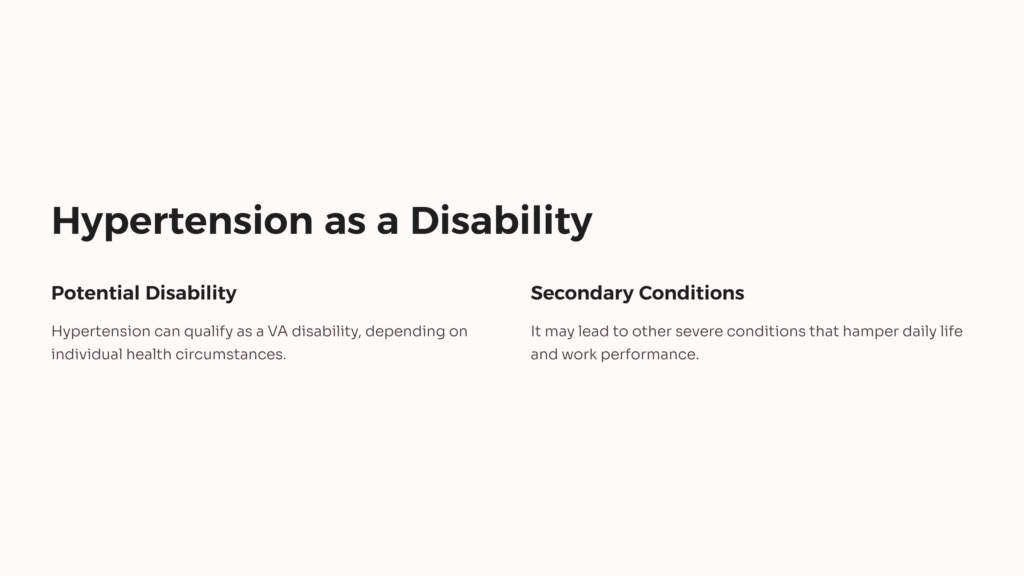Hypertension, commonly known as high blood pressure, is a medical condition that many people worldwide grapple with. It exposes individuals to numerous health risks, making everyday life and normal functioning challenging. While it is an issue among the general populace, it specifically poses a significant concern for veterans. This article revolves around hypertension in the context of Veteran Affairs (VA) ratings, providing a comprehensive view of the matter, from understanding the disease to how it impacts VA ratings.
Understanding Hypertension

Hypertension, colloquially known as ‘the silent killer’, is a condition where the force of blood against an individual’s artery walls is consistently too high. This excessive pressure causes the heart to work harder to pump blood, leading to the hardening of the arteries, or atherosclerosis, which further could trigger heart disease and strokes.
A multitude of factors contribute to the development of hypertension. These include age, genetics, obesity, stress, high salt intake, alcohol consumption, and lack of physical activity. Unfortunately, high blood pressure takes its toll over an extended period, increasing the risk of a heart attack, stroke, kidney disease, and in serious cases, death.
Hypertension as a Disability

Much debate surrounds whether hypertension can be regarded as a disability. While it is not always directly disabling, it paves the way for other severe secondary conditions that could hamper day-to-day life and work performance. Therefore, largely depending on the individual’s health circumstances, hypertension has the potential to qualify as a VA disability.
Understanding VA Ratings
The Veterans Affairs (VA) department, established in 1930, serves as the government authorized body overseeing issues related to veterans and veterans disability. A significant aspect of their work is the VA disability rating system which is used for rating disabilities in order to determine the amount of monthly compensation. The VA rates disabilities from 0% to 100% in 10% increments, calculating the severity of a veteran’s condition and its impact on their regular life. These ratings play a pivotal role in determining the veterans disability benefits a veteran can receive. The VA disability calculator can also take into account several disabilities and give a total disability rating for the amount of disability compensation the veteran can receive.
Hypertension VA Ratings
The hypertension VA rating is based on blood pressure reading, with ratings varying from 0%, 10%, 20%, and even up to 60% in extreme cases. Factors affecting these rates include the consistency of high blood pressure readings over multiple evaluations and supporting medical data from private physicians or VA medical facilities to validate A VA disability claim for hypertension.
Navigating the process of the VA disability rating for a hypertension claim can be complex for veterans unfamiliar with the system. It involves providing adequate medical evidence from VA or private physicians showing historically high blood pressure readings for either systolic pressure or diastolic pressure. Veterans must also describe in detail how the condition disruptively influences their daily routine activities such as impacts to employment, relationships, mood, and quality of life. Outlining specific examples of lifestyle limitations due to hypertension can help attest to the validity and severity of the hypertension claim.

However, receiving an accurate hypertension VA rating that fully encompasses the extent of the disability could make a significant difference in the lives of veterans dealing with this chronic condition. Higher ratings lead to increased VA disability benefits. These VA benefits play a huge part in easing financial burdens from medical costs or loss of work capacity. VA disability benefits also provide healthcare resources and prioritized access to treatments. Putting together a robust VA disability claim package including extensive medical evidence and detailed statements on disability impacts with the VA form is key. Utilizing veteran service representatives can also streamline compiling the disability compensation claim and answering procedural questions.
To help illustrate, consider two hypothetical examples. In the first, a veteran suffering from hypertension has a VA rating of 60%. This high rating is due to persistent high blood pressure readings and subsequent secondary conditions such as heart disease and kidney damage.
In our second example, a veteran with hypertension has a VA rating of 10%. Here, high blood pressure readings are sporadic, and there are no secondary ailments. Hence, the lower rating reflects the less severe impact of the condition on the veteran’s life.

Resources for Veterans with Hypertension
Numerous resources are available to veterans grappling with hypertension. The VA’s comprehensive healthcare system offers regular medical check-ups, various therapies, medicines, and lifestyle advice. Once enlisted for VA benefits, veterans can avail of these resources, mitigating the impact of hypertension on their daily lives.
Conclusion
Understanding hypertension and the VA rating system is crucial for veterans to utilize the benefits they are entitled to. Despite the challenges, living with high blood pressure doesn’t have to be debilitating. By availing of the benefits accorded to their VA ratings, they can manage their condition effectively.
 AllVeteran.com Advisors
AllVeteran.com Advisors
With expertise spanning local, state, and federal benefit programs, our team is dedicated to guiding individuals towards the perfect program tailored to their unique circumstances.











